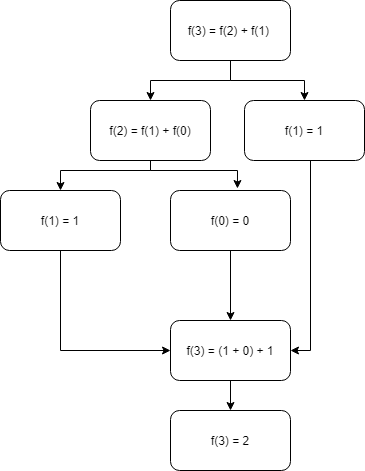Programming logic exercise
I'm still crawling in this world of programming and have tried to solve a logic problem by myself involving the Fibonacci sequence. Unfortunately I did not succeed and after searching the internet, I found the same solved:
var fibonacci_series = function (n) {
if (n === 1)
{
return [0, 1];
} else {
var s = fibonacci_series(n - 1);
s.push(s[s.length - 1] + s[s.length - 2]);
return s;
}
};
My question is: why does if receive this condition (n === 1) and return an array, and why is this condition false and falls directly into else?
From now on I thank everyone who provides a time to heal my I doubt and ask you to provide some content that can add value to my studies.
1 answers
Hello, Rafael! To avoid any doubt regarding the subject as a whole I will address from what is the Fibonacci sequence to the functioning of recursive functions and the function you presented ok? Come on!
Fibonacci sequence
Such a sequence is governed by the following Rule:
The next value of the sequence is equal to the sum of its two predecessors.
Ex.: considering an excerpt from the sequence: 2,3,5.. the successor number of 5 will be 3 + 5 = 8, the successor number of 8 would be 8 + 5 = 13 and so on...
Recursion
Every recursion algorithm is based on the Three Laws of recursion:
1st Law: every recursive function has a base case.
In this function displayed in the image the base cases are:
2nd Law: a recursive algorithm must change its state and approach its base case.
Our function changes state whenever the value of n changes and approaches the base case, as we repeatedly approach 1 due to the return:
fibo(n-1) + fibo(n-2)
(n-1) and (n-2) are responsible for making the state change and indicating the two predecessors of n.
The recursive call of an excerpt of function ex.: fibo(n-1) ends when we arrive at the case where fibo (1) is equal to 1 and fibo(0) is equal to 0.
When all snippets of the function are resolved the final call returns the value of fibo.
Ex.: fibo(3)
[estado inicial: n=3] se n =3, então fibo(3) = fibo(2) + fibo(1).
[estado de transição: n=1] se fibo(1) = 1, então fibo(3) = fibo(2) + 1.
[estado de transição: n=2] se n = 2, então fibo(2) = fibo(1) + fibo(0).
[estado de transição: n=1] fibo(1) = 1 e fibo(0) = 0, então fibo(2) = 1 + 0.
Finally
[estado final: n=3] fibo(3) = (fibo(1) = 1 + fibo(0) = 0) + (fibo(1) = 1)
Or
[estado final: n=3] fibo(3) = (1 + 0) + 1
It is noticed that we divide each part of the problem into smaller parts until these smaller parts reach our base case.
A graphical representation to get more clear:
3rd law: every recursion algorithm must call itself.
This rule is already demonstrated in the example above, after all called fibo(n) = fibo(n-1) + fibo(n-2).
To be clear, another example of a function that calls itself is the Calculate factorial function:
fatorial(x) = x * fatorial(x-1) , but let's put it aside right now and focus on what we have here.
Simple Recursive Function.
Ex.: knowing that the first 10 fibonacci elements are:
[0, 1, 1, 2, 3, 5, 8, 13, 21, 34, 55]
The function I will show below returns:
fibonacci(0) = 0, fibonacci(1) = 1, fibonacci(2) = 1, fibonacci(3) = 3 ... fibonacci(9) = 55
function fibonacci(n)
{
if (n === 0)
{
return 0
} else
{
if (n === 1)
{
return 1
} else
{
return fibonacci(n-1) + fibonacci(n-2)
}
}
}
In psudocode the equivalent would be:
chame funcao(n)
se n é igual a 0, entao
retorne 0
se n não é igual a 0, mas é igual a 1, entao
retorne 1
se n não é nem igual a 0 nem igual a 1, então
chame funcao(n-2) até que n seja igual a 1 ou a 0
chame funcao(n-1) até que n seja igual a 1 ou a 0
retorne o resultado de funcao(n-2) + o resultado de funcao(n-1)
Function Displayed
var fibonacci_series = function (n) {
if (n===1)
{
return [0, 1];
} else {
var s = fibonacci_series(n - 1);
s.push(s[s.length - 1] + s[s.length - 2]);
return s;
}
};
In psudocode the equivalent would be
chame funcao(n)
se n é igual a 1, entao
retorne uma lista [0,1]
se n não é igual a 1, entao
insira em s:
A lista de elementos antecessores ao numero de posição n na sequencia de fibo.
Ex.: s = [0,1]
acrescente ao final da lista em s:
A soma do ultimo elemento da lista com o penúltimo elemento da lista.
Ex.: s[2] = 1 + 0 = 1; s = [0,1,1]
retorne a lista em s
Ex.: [0,1,1]
Note that instead of using if n == 0 and if == 1 the function simply considered 1 and returned the two values, making the function more efficient as this eliminates the need to execute the f(0) = 0 statement, it improves considerably the efficiency of the algorithm since one of the problems of recursion is the execution of the same calculation several times.
I recommend you try to do the steps on paper, so you will have a sense of the steps of recursion.
If there is any error please correct me. I hope I helped somehow.
Hug.




